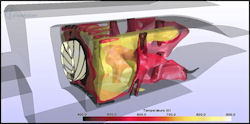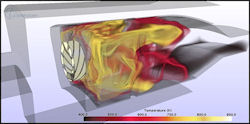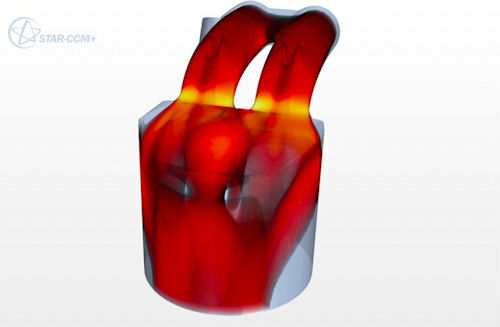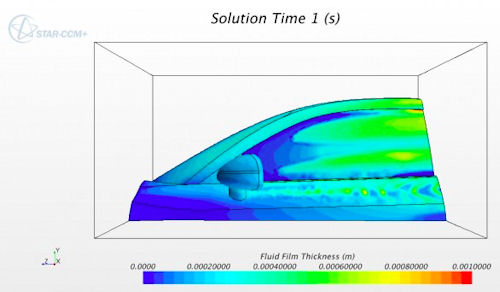See Inside Flow Field Simulations
STAR-CCM+ Version 9.02 enhanced with volume rendering capability, also has new Dispersed Multiphase model to speed water impingement analyses.
March 12, 2014
CD-adapco (Melville, NY, and London, UK) announced the release of STAR-CCM+ v9.02 of its CFD (computational fluid dynamics) system for solving engineering problems involving the flow of fluids or solids, heat transfer and stress. Calling v9.02 a major release of its flagship simulation system, the company reports that this version focuses on productivity and simulation turnaround time as well as a range of new application areas while making simulation more realistic for users.
“In STAR-CCM+ v9.02 we enhanced our workflow capabilities and the speed and scalability of our solvers,” said Senior VP of Product Management, Jean-Claude Ercolanelli in a press statement. “All aspects of our v9 release cycle will stay focused on adding realism to the simulations, and driving optimal results for customers in a shortened amount of time.”
To that end, the 9.02 version of STAR-CCM+ introduces a new volume rendering capability, a new tumble and swirl cost function in the adjoint solver and a new Dispersed Multiphase model for investigating the behavior of impinging water droplets.
 |  |
| STAR-CCM+ v9.02 introduces volume rendering visualization methods. The image on the left depicts using iso-surfaces to show temperatures in a combustion chamber. The screen shot on the right depicts using volume rendering techniques to discover the temperature within a combustion chamber. Images courtesy of CD-adapco. | |
CD-adapco describes its new volume rendering capability as allowing engineers to “see inside” a flow field. To visualize pressure, temperature, species concentration, turbulence intensity and similar quantities engineers traditionally have used surfaces such as domain boundaries, artificial sections through the model or iso-surfaces. Volume rendering generates a deeper picture of what’s happening in a flow field by using a set of volume elements, voxels, to which opacity, color and lighting attributes are applied. STAR-CCM+ breaks down the voxel set into a resampled volume and applies adaptive resampling methods to manage the computational cost of volume rendering by changing the cell size to voxel ratio.
The STAR-CCM+ adjoint solver is said to help engineers understand how changes in geometry and flow features can influence a system’s performance by providing direct access to sensitivity information from a single simulation. The developer says that it has enhanced the STAR-CCM+ adjoint solver in v9.02 with a number of new features that broaden the solver’s applicability and make it easier to use.
 The adjoint solver in STAR-CCM+ v9.02 offers a new tumble and swirl cost function. Image courtesy of CD-adapco. |
One adjoint betterment CD-adapco highlights is a new tumble and swirl cost function, which, it says, targets the IC engine community. This new function allows for sensitivities to be presented with respect to a key metric used in steady-state port flow analyses. In such studies, explains CD-adapco, improving the tumble and swirl characteristics of the port are critical.
To extend ease-of-use, v9.02 migrates the adjoint cost function to the standard STAR-CCM+ reporting capability. This, according to CD-adapco, allows engineers to understand whether the cost functions they are interested in are returning sensible values before they run the adjoint solver. Further, all STAR-CCM+ users can benefit from the new tumble and swirl report because the report is available whether or not a user has interest in the adjoint solver.
The new Dispersed Multiphase model is engineered for such simulation applications as aircraft deicing/anti-icing, vehicle soiling and water management. The Dispersed Multiphase model is described as a lightweight, computationally efficient, Eulerian model. It works by treating impinging water droplets as a continuous background phase superimposed on the single-phase primary flow.
 CD-adapco says the Dispersed Multiphase model introduced in STAR-CCM+ v9.02 can simulate impinging water droplets in a fraction of the time than previous methods. Image courtesy of CD-adapco. |
The new Dispersed Multiphase model is reported to result in simulations that are much less computationally expensive than the Lagrangian equivalent and that do not need the full physics capability of Eulerian Multiphase modeling. According to the company, impingement simulations will now take a fraction of the time compared to earlier approaches. CD-adapco says a Dispersed Multiphase model approach assures a smooth and repeatable impingement pattern on the geometry being modeled.
STAR-CCM+ v9.02 will make its public debut next week (March 17-19) at the STAR Global Conference 2014 in Vienna, Austria. For further details on STAR-CCM+ v9.02, visit CD-adapco.
Go here for more on volume rendering in STAR-CCM+ v9.02.
Go here for more on the new Dispersed Multiphase model in STAR-CCM+ v9.02.
See why DE’s editors selected STAR-CCM+ v9.02 as their Pick of the Week.
Sources: Press materials received from the company and additional information gleaned from the company’s website.
Subscribe to our FREE magazine, FREE email newsletters or both!
About the Author
Anthony J. Lockwood is Digital Engineering’s founding editor. He is now retired. Contact him via [email protected].
Follow DE





